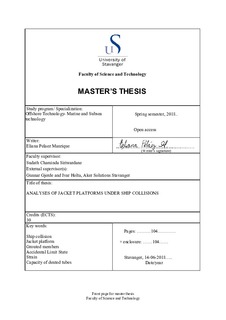| dc.description.abstract | Ship collisions with jacket platforms constitute a risk to the facility integrity, the personnel and the environment. Visiting vessels are used in the Norwegian Continental Shelf to handle different goods and materials for offshore platforms. In general, platforms with four legs are highly common worldwide, and the study of the forces than arise from ship impacts have been studied since latest 80’s. Thereby, jacket platforms were designed to support impact energies of 11 MJ and 14 MJ for head-on and side collision, respectively. With the increase in weights and more sophisticated navigations programs, the impact energies have enlarged considerably. Recent updates in guidelines as in Norsok Standard N-003 suggest impact energies of 28 MJ and 50 MJ for side and head-on collision, correspondingly, when no detailed risk analysis is performed. In other words, this represents an increase in the demand of dissipation energy from the platform structure.
This report compiles parametric studies performed in USFOS, for steel and steel grouted tubes with different ratios D/t (diameter/thickness) and constant length. The tubes are fixed at the ends in all degrees of freedom, and impacted at mid-span. Strain fracture (0.15) is accounted for failure criteria. Moreover, the numerical results are compared to different sources of experimental data, as well as the force-deformation relationships provided by Veritas DNV-RP-C204 and Norsok Standard N-004, assigned in this study as the simplified method. Very satisfactory agreement is found in impact force predictions and overall absorption energies. Likewise, details of the membrane effects in the resistance to denting and bending are shown in non-dimensional graphs.
Furthermore, boat impact analyses are conducted in two platforms, they are denominated as, Platform A and Platform B, the aim is to check their capacity to dissipate an impact energy of 50MJ. Correspondingly, different scenarios of impacts on leg/brace members are investigated. An approach of a quasi-static analysis and finite element computer program are used to simulate the impact loads. A summary of the energies absorbed, impact forces, global displacements and local dents in the members is presented for each platform. Failure criteria is taken according to Veritas DNV-RP-C204 and Norsok Standard N-004. The boat impact analyses include the absence or presence of concrete in the leg/brace under impact. The difference and gains from the use of concrete filled members are also reported.
Additionally, a dynamic analysis in Platform B is performed under different velocities 3.0m/s, 3.5m/s, and 4.0m/s with constant impact energy of 50MJ. The dynamic amplification ratios for the base shear force, and the over-turning moment are calculated as, the ratio between the dynamic response to the static response. An increase of 42% in the base shear force and 25% of the overturning moment is found when the ship impacts a hard point in the platform, for example a leg joint.
Finally, the axial capacity of dented tubes is numerically tested in USFOS. The parametric study consists in an axially-free steel tube, that is subjected to impact energy to produce a dent between 50%-60% of the diameter. Afterwards, the tubes are axially loaded in compression to investigate the remaining axial capacity of the dented tubes. The failure is assumed when the member is incapable of taking more load or when the strain reaches the critical value of 0.15. | nb_NO |

